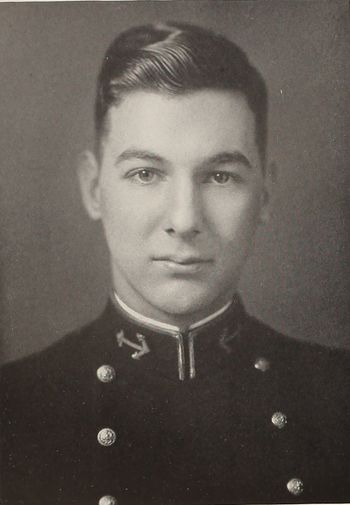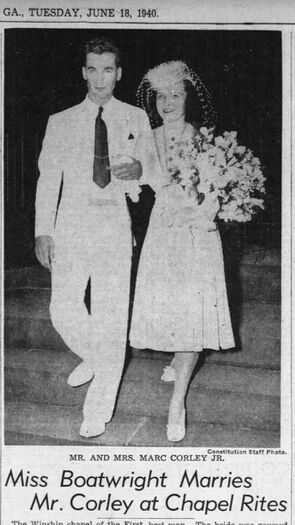MARCUS L. CORLEY, JR.
Marcus Corley, Jr. '36
Lucky Bag
From the 1936 Lucky Bag:
Marcus Leo Corley, Jr.
Zwolle, Louisiana
"Mark"
HAIL to Marcus, from the state of the many bayous. Marcus is quite a lad; between figuring new ways to goldbrick, practising walking on his hands, and deciding which Crab to look after, he does a good job of staying sat, even though he spent three years boning la bella lingua delli Fascisti. One of his characteristics is the rare, though at times annoying, gift of eternal blissfulness—never a care in the world; even here! Blame it on his youth, naïveté, or what have you; it's beyond us. Mark usually comes out on top through various and sundry ways, but he never let the secret of his success out. His ambition is to get back to his good ole cawn pone and pot likker. Let's hope his angel continues to look out for him. Here's to you, Mark!
Log 4; One Stripe.

Marcus Leo Corley, Jr.
Zwolle, Louisiana
"Mark"
HAIL to Marcus, from the state of the many bayous. Marcus is quite a lad; between figuring new ways to goldbrick, practising walking on his hands, and deciding which Crab to look after, he does a good job of staying sat, even though he spent three years boning la bella lingua delli Fascisti. One of his characteristics is the rare, though at times annoying, gift of eternal blissfulness—never a care in the world; even here! Blame it on his youth, naïveté, or what have you; it's beyond us. Mark usually comes out on top through various and sundry ways, but he never let the secret of his success out. His ambition is to get back to his good ole cawn pone and pot likker. Let's hope his angel continues to look out for him. Here's to you, Mark!
Log 4; One Stripe.
Loss
Marcus was lost when the two-engine B-34 bomber he was ferrying crashed near Cape Palmas, Liberia, on August 29, 1942. One engine had failed two hours at sea. He was the plane's navigator.
Other Information
He was survived by his wife, parents, and brother; he is buried in Tunisia.
From the December 1942 issue of Shipmate:
CHARLES J. ELLIS, '36, (Lt., USNR), 610 H. St., N. E., Washington, D. C, sends in this interesting data on "Marc" L. Corley, '36, and adds: "Damn good evidence that the alumni who aren't back in are really doing their bit:"
By JOE MORTOX Associated Press Correspondent
3 U. S. FLYERS LOSE AT 100-1 IN GAMBLE TO DELIVER BOMBER
Ferry Pilots Scorn Safety of Internment For Long Chance to Go Through.
Somewhere in West Africa, Oct. 9 (Delayed)—The list of heroic Americans killed in action in the cause of their country has been lengthened by three fearless bomber ferry flyers who swapped the safety of internment for a 100-1 chance to deliver the goods.
They are Emmett F. Clausewitz, pilot; E. G. Kail, first officer, and MARCUS L. CORLEY, '36, navigator, the latter from Miami, Florida.
Their twin-engined aircraft, crippled in flight across the Atlantic, crashed after a desperate do-or-die effort to get beyond Vichy territory.
The wreckage was found on friendly soil—just a mile across the line.
First word that the three men were in trouble came to a United Nations base where I was visiting.
""One engine is gone," they radioed. "What do you suggest?"
The base control officer took note of their position.
"You are nearing Vichy territory," he told them. "The beach is level and hard. I think you can get down O.K. But your plane will be confiscated and you will be interned."
LANDED TO DELIVER BOMBER
He told them, too, that the nearest friendly country offered nothing but a narrow strip of sand flanked by a rough plain and thick mangrove swamps. The decision was up to them.
The three men made their choice. They decided to deliver the bomber at the risk of their lives. There was no further word from them.
Eighteen hours later a veteran Pan American Airways pilot, Steve Shaw of Northampton, Mass, found the pile of smouldering wreckage. He made sure there were no survivors, then came back to the base for assistance.
Six men, myself among them, volunteered and climbed into his Grumman amphibian. After cruising two hours we again spotted the tragic ash-gray cross on the ground, and dropped softly into a small, uncharted lagoon.
An hour of steady walking through the jungle and down the beach brought us to the plane. The remains of the wing and fuselage had to be lifted away before the charred bodies could be found.
A strange procession bore the three bodies back to the amphibian. A youthful officer led the way, followed by the native bearers carrying the tragic burden in an improvised canvas sling attached to long poles. Others in the rescue group, soaked in perspiration from laboring under the equatorial sun, brought up the rear.
PLANE BARELY CLEARED TREES
A superstitious native chief appeared en route to ask that the procession not go through his village.
At the lagoon where the Grumman floated, dugout canoes had to be obtained to ferry the bodies out from shore. Overloaded by the added burden, the plane barely cleared the trees in the takeoff. Darkness descended before it got back to the base airport, lighted only by flares.
The next day an African Flanders Field received the three heroes with full military ritual. Three volleys echoed across a warm hillside and down through a forest of rubber trees before the minister slowly intoned the benediction.
"We commit the bodies of these heroes who died in the cause of freedom and the things we hold dear, and ask that everlasting consolation be their portion."
From researcher Kathy Franz:
Marcus graduated from Zwolle High School and attended Louisiana Normal College for one year. He graduated from the Naval Academy but failed the physical test and resigned. Many who failed did not meet the eye standards.
He married Frances Boatwright in June 1940 and was a special agent in Florida for the Maryland Casualty Company. He became a navigator for the Pan-American Ferries. His parents were Mr. and Mrs. M. L. Corley, and his brother was Glyn.
Photographs
Memorial Hall Error
Though he was not a member of the armed forces—he was employed by Pan American Air Ferries—believe he should still be included in Memorial Hall. His loss was in the performance of military duties and aboard a military aircraft. Had he landed in neutral territory he would have been interned based on his occupation. He is buried in a military cemetery.
Marcus was identified through the diligent efforts of Leslie Poche, a volunteer who combed through Shipmate issues to find operational losses not accounted for in Memorial Hall.
Marcus is one of 39 members of the Class of 1936 on Virtual Memorial Hall.

The "category" links below lead to lists of related Honorees; use them to explore further the service and sacrifice of alumni in Memorial Hall.

